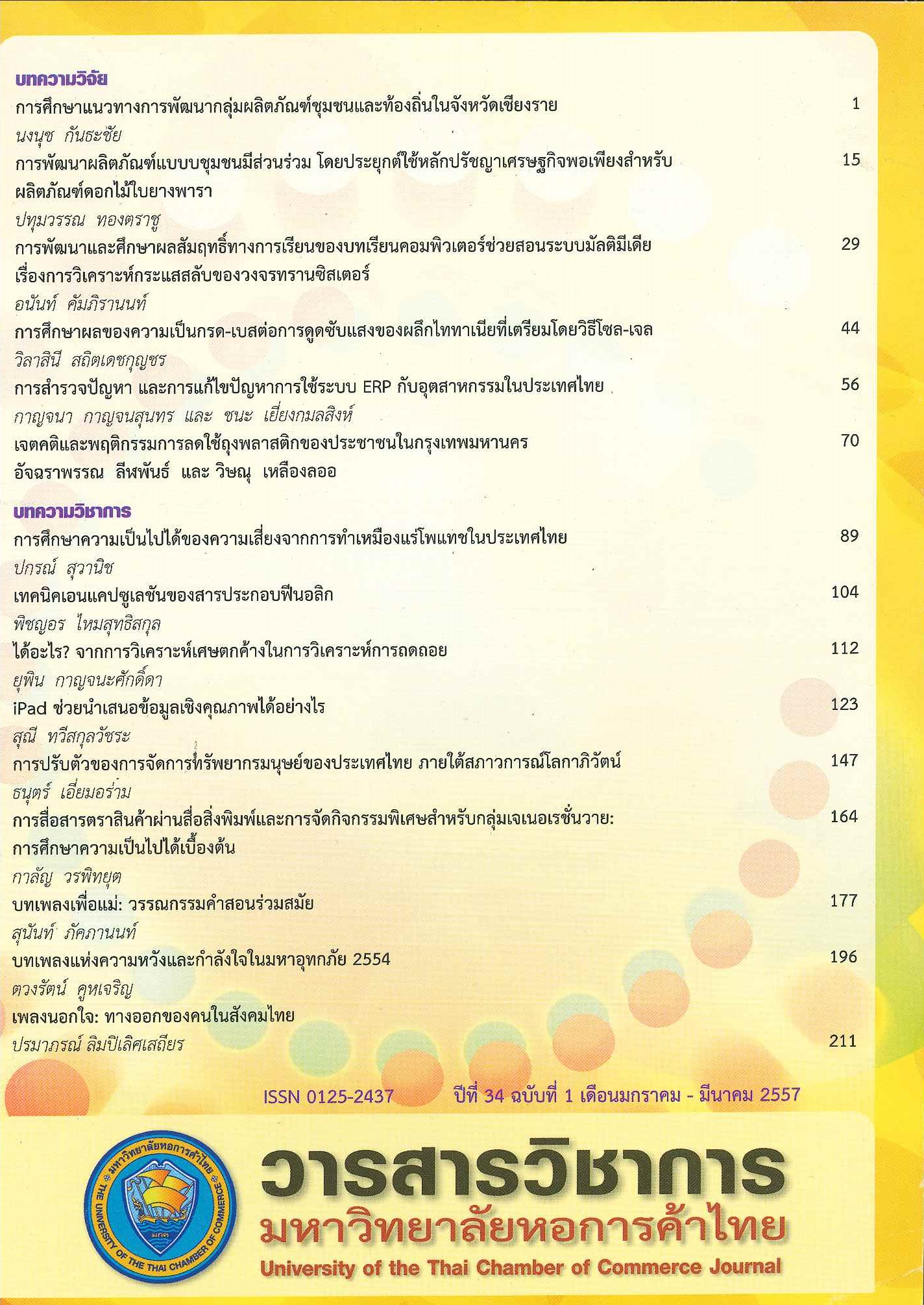The Study of Potash Mining Risk Possibility in Thailand
Main Article Content
Abstract
Risk possibility studies of potash mining in Thailand become necessary because potash will soon be widely mined in Northeast Thailand. This paper reviews previous comparative documents to learn the former risk impacts from potash mining in many other places of the world, such as Carlsbad in New Mexico State, USA, Saskatoon, Saskatchewan in Canada and many places in Europe, such as Germany, Poland, Ukraine and in Russia, where the potash mines were first operated more than a hundred years ago. The reason for this comparative study is that the exploitation of potash resource in Thailand is in the initial stage following the Department of Mineral Resources revelation of a huge and good reserve of potash deposits and the publication of the details in 1973.
There are many types of potash mining, but one of the most popular operations is an underground mine that differs from a tunnel mine. Normally, the underground potash is more likely to be developed as a mine since the potash minerals usually occur as layers underneath the plain of a basin. The underground mine can be more advantageous than solution mining because the operations can be controlled by humans.
Although the underground mine seems to be an appropriate method for the potash minerals, some risks or hazards remain and the environmental impacts are little known. The hazards from potash mining in this world may occur from flooding in the underground mine, explosions from gases in the potash minerals or intrusion of igneous rocks in the potash strata or an earthquake collapses the mine. These phenomena may occur this time in Thailand if insufficient attention is paid to the possible risks by appropriate individuals or organizations. The best practice knowledge of risk and prevention should therefore be applied and executed.
Article Details

This work is licensed under a Creative Commons Attribution-NonCommercial-NoDerivatives 4.0 International License.
ลิขสิทธิ์ของบทความ
ผลงานที่ได้รับการตีพิมพ์ถือเป็นลิขสิทธิ์ของมหาวิทยาลัยหอการค้าไทย ห้ามมิให้นำเนื้อหา ทัศนะ หรือข้อคิดเห็นใด ๆ ของผลงานไปทำซ้ำ ดัดแปลง หรือเผยแพร่ ไม่ว่าทั้งหมดหรือบางส่วนโดยไม่ได้รับอนุญาตเป็นลายลักษณ์อักษรจากมหาวิทยาลัยหอการค้าไทยก่อน
References
Anon. 1992. "Easterhazy Replacement Approved." Phosphate & Potash No. 180: 13-16.
Duchrow, G. 1990. "The Production of Potash in East Germany." Glueckauf 126, 21/22: 1016-1033.
Garrett, D.E. 1996. Potash Deposits, Processing, Properties and Uses. London: Chapman and Hall.
Gessel. W. 1972. "Outbursts of Carbon Dioxide in Potash Mines." Earth Science 1: 235-239.
Hasegawa, H.S., Wetmiller, R.J., and Gendzwill, D.J. 1989. "Induced Seismicity in Mines in Canada: -An Overview." Pure and Applied Geophysics 129, 3/4: 431-438.
Hurtig, E., et. al. 1984. "Implications for Predicting Mining Tremors." In Zent Institution of Physic, pp. 351-369 Erdeasked, WI: DDR.
Knoll, P. 1990. "The Fluid-Induced Tectonic Rockburst of March 13, 1989 in the Werra. GDR. Potash District." In Rocks at Great Depth, pp. 1415-1424. Amstetdam: Balkema.
Kovtun, V., Sbizov, R., and Yeliseyev, V. 1991. "Problems, Experience, and Technology Improvement in Mining Multiple Bed Potash." In Kali '91, pp. 231-243. Amsterdam: Springer.
Prugger, F.F., and Prugger, A.F. 1991. "Water Problems in Saskatchewan Potash Mining." Canadian Institute of Mining Bulletin 84, 945: 58-66
Smith, R.C. 1988. "Conversion of a Flooded Potash Mine to Solution Mining." In Raw Materials, pp. 117-121. Phoenix, AZ: International Fertilizer Industry Association.
Suwanich, Parkorn. 1978. Potash Minerals in Northeastern Thailand. Bangkok: Economic Geology Division, Department of Mineral Resources. (in Thai).
ปกรณ์ สุวานิช 2521 แร่โปแตชภาคตะวันออกเฉียงเหนือของประเทศไทย กรุงเทพมหานคร: กองเศรษฐธรณีวิทยา กรมทรัพยากรธรณี
Suwanich, Parkorn. 1983. "Potash and Rock Salt in Thailand." In Conference on Geology and Mineral Resources of Thailand, pp. 56-67. Bangkok: Department of Mineral Resources.
Suwanich, Parkorn. 1986. Potash and Rock Salt in Thailand. Bangkok: Economic Geology Division, Department of Mineral Resources.
Suwanich, Parkorn. 2007. Geology of Potash and Rock Salt Minerals in Thailand. Bangkok: Kampeewan. (in Thai).
ปกรณ์ สุวานิช 2550 ธรณีวิทยาแหล่งแร่โพแทช-เกลือหินของไทย กรุงเทพมหานคร: คัมภีร์วรรณ.
Suwanich, Parkorn. 2011. "A Comparative Study of Rock Formations Composed of Rock Salt and Potash Layers between Thailand and Lao PDR." University of the Thai Chamber of Commerce Journal 31, 4: 85-96. (in Thai).
ปกรณ์ สุวานิช 2554. "การศึกษาเปรียบเทียบหมวดหินที่ประกอบด้วยชั้นเกลือหินและโพแทชของประเทศไทยและลาว" วารสารวิชาการมหาวิทยาลัยหอการค้าไทย 31, 4: 85-96
Suwanich, Parkorn. 2012. "Geological Map of Phutok Formation Improvement Explored from Potash and Rock Salt Drilled Holes, Topography and Outcrops on the Khorat Plateau." Khon Kean University Research Journal 17, 1: 58-70. (in Thai).
ปกรณ์ สุวานิช 2555 "การปรับปรุงแผนที่ธรณีวิทยาหมวดหอนภูทอกที่ได้จากหลุมเจาะสำรวจเกลือหินและโพแทชจากลักษณะภูมิประเทศและจากหินโผล่บนที่ราบสูงโคราช" วารสารวิจัย มข. 17, 1: 58-70
Thailand. Department of Mineral Resources. 2005. Risk Map of Earthquake in Thailand Bangkok: Department of Mineral Resources. (in Thai).
กรมทรัพยากรธรณี 2548 แผนที่บริเวณเสี่ยงภัยแผ่นดินไหวของประเทศไทย กรุงเทพมหานคร: กรมทรัพยากรธรณี
Turner, R. 1984. "Brazil Readies New Potash Mine." Engineering and Mining Journal 185, 12: 50-51.
Zemskoff, A.N., and Smichnik, A.P. 1991. "Mechanism of Gas Generation in Potash Beds of the USSR Verkhnekamsk and Starobin Deposits." In Kali '91, pp. 65-76. Amsterdam: Springer.


